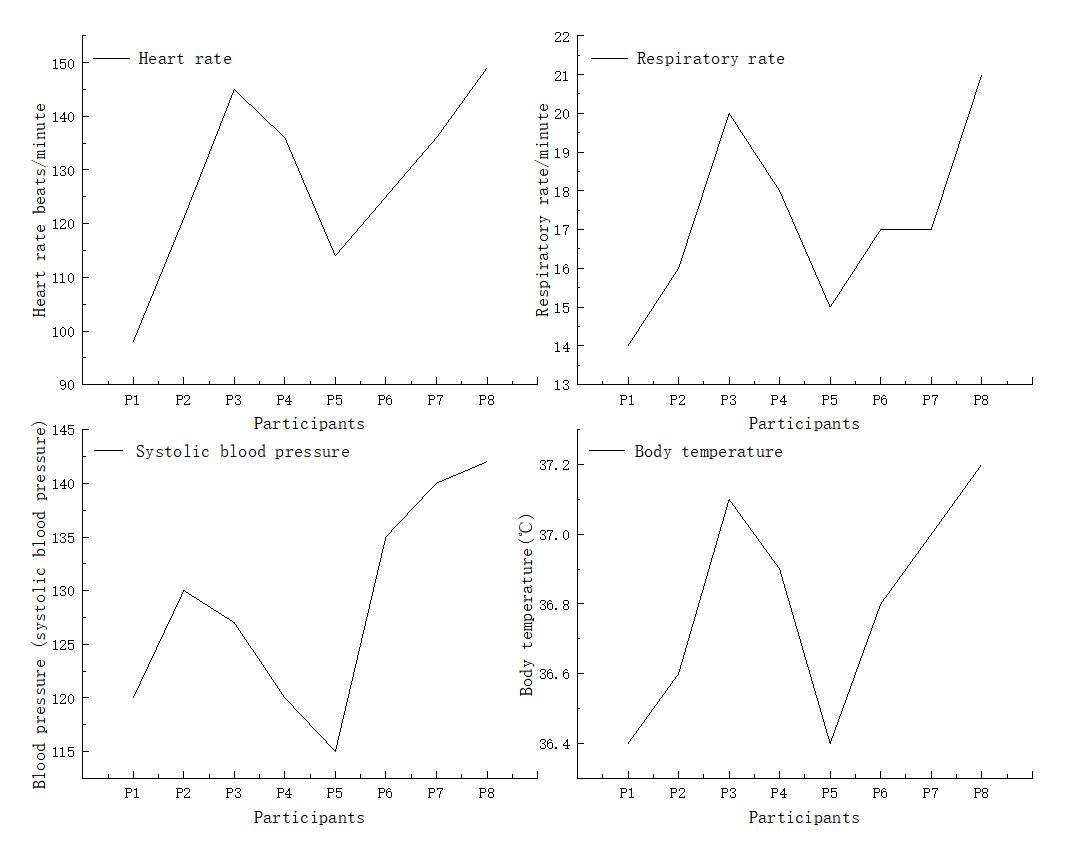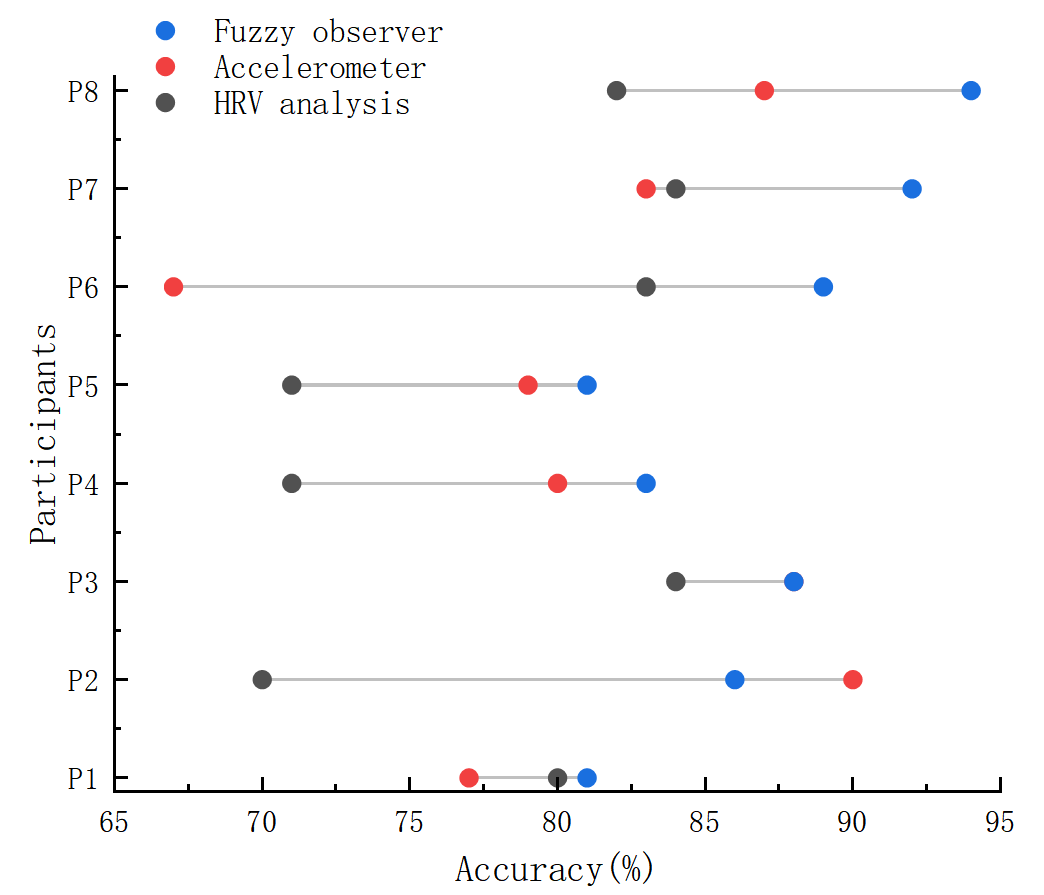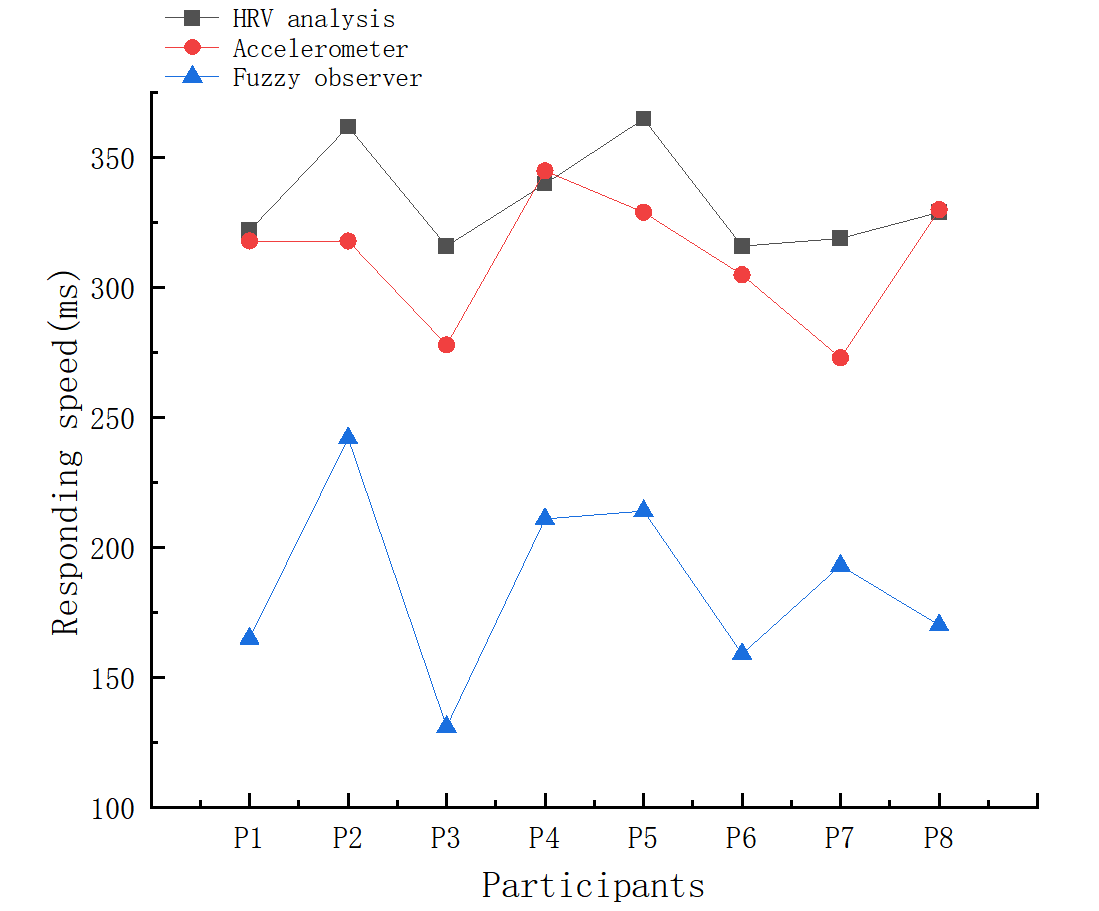1. Introduction
With the progress of society, people's demands for physical fitness are increasing, and exercise is an effective means to improve physical fitness [1]. The human body generates a certain amount of exercise intensity during exercise, but this process often causes certain damage to the human body. By evaluating the intensity of human movement, problems in human movement can be identified in a timely manner, and measures can be taken to prevent or treat them in a timely manner. At present, the assessment of exercise intensity mainly relies on subjective judgment and objective measurement. However, due to the subjectivity of human subjective consciousness, it is difficult to ensure the authenticity and objectivity of the obtained data [2-3].
In response to this issue, this article establishes a fuzzy observer to evaluate the intensity of human motion. Based on the deviation between the actual system output value and the expected value, this paper uses a fuzzy observer to construct a new prediction model. Afterwards, it evaluates the superiority and inferiority of the fuzzy observer based exercise intensity evaluation algorithm designed in this paper through the analysis of heart rate variability and the application data of accelerometers in exercise intensity evaluation. This article further optimizes the algorithm by comparing data on accuracy, response speed, and participant satisfaction.
2. Related Works
In recent years, with the improvement of health awareness, accurate assessment of exercise intensity has become increasingly important, and more and more scholars have also conducted research on this. Accurately assessing exercise intensity is crucial for developing personalized training plans and monitoring exercise outcomes in the fields of sports science and cardiovascular rehabilitation. Recently, fuzzy observers have been widely studied for evaluating exercise intensity due to their efficient ability to handle fuzzy and uncertain data [4]. The studies of Nguyen A T and Anselmi F respectively demonstrate the application of nonlinear description and ventilation threshold techniques in evaluating cardiovascular rehabilitation and exercise intensity [5-6]. Hansen D discussed the importance of evaluating and prescribing exercise intensity in cardiovascular rehabilitation, emphasizing the crucial role of accurately assessing exercise intensity in personalized treatment and rehabilitation [7]. Rose G L studied the impact of exercise intensity on chronic inflammation, provided the relationship between exercise intensity and health, and emphasized the importance of accurately assessing exercise intensity [8]. Edwards K H and Keir D A revealed the impact of exercise intensity on different systems in the human body and proposed new methods and strategies to evaluate exercise intensity [9-10].
Due to the influence of various factors on human movement, establishing a reasonable fuzzy observer requires considering these factors. This article evaluates human motion intensity by establishing a fuzzy observer. Firstly, the relationship between measurement variables and state variables is processed using the fuzzy set theory in fuzzy system theory. Then, this method is used to evaluate human motion intensity.
3. Methods
3.1. Classification of Human Exercise Intensity
In order to achieve the classification of human exercise intensity, it is necessary to use an algorithm that can accurately classify. This article can use fuzzy logic classification functions to classify human exercise intensity. By consulting relevant literature, it was found that there is currently no unified standard for different exercise intensities in the world, but they are mainly classified into three intensity categories: anaerobic exercise intensity, maximum heart rate intensity, and duration intensity [11-12].
Anaerobic exercise intensity refers to the energy generated by anaerobic metabolism of the oxygen consumed by the human body during exercise. Anaerobic exercise can accelerate the respiration of mitochondria in cells and improve the body's metabolic capacity. When the human body undergoes anaerobic metabolism, it consumes a large amount of energy and produces a large amount of substances such as lactic acid, which can cause certain harm to the body. Therefore, a certain amount of energy reserve is required for anaerobic metabolism. The maximum heart rate refers to the heart rate value corresponding to the maximum heart rate of the human body in a resting state. In general, the maximum heart rate of a person in a quiet state is 220 minus age. The maximum heart rate range for people of different ages is 130-220 beats per minute. Duration refers to the amount of oxygen consumed by the human body at different times. In general, the amount of oxygen consumed by the human body is the lowest when in a stationary state, while the oxygen demand and energy consumption of the body significantly increase when in a moving state. When a person is in a resting state, their oxygen consumption is slightly higher than that of a resting state, but much lower than that of an active state. The oxygen consumption under fatigue depends on the degree and cause of fatigue. If fatigue is caused by high-intensity exercise, the oxygen consumption may still be high at the beginning of the exercise because the body needs more oxygen to recover.
In order to ensure the effectiveness of the observer, this article divides human exercise intensity into five levels based on physiological indicators such as heart rate, energy expenditure, and respiratory rate, including warm-up and relaxation, anaerobic exercise, lactate threshold, aerobic exercise, and fat burning and endurance. The intensity of warm-up and relaxation exercises is lower, and the body is prepared for higher intensity exercises through relaxed activities. During anaerobic exercise, the body's energy mainly comes from anaerobic metabolism. This type of exercise is usually high-intensity, short-term, including weightlifting, sprinting, etc. Anaerobic exercise can improve explosive power and muscle strength. Lactic acid threshold level, high exercise intensity, and prolonged use can lead to lactate accumulation. At this point, the body's energy supply is in a transitional stage between aerobic and anaerobic metabolism. The body's energy during aerobic exercise mainly comes from aerobic metabolism. This type of exercise is usually of medium to low intensity but with a longer duration. The exercise intensity during the fat burning and endurance stages is moderate, with the aim of promoting fat burning and improving body endurance through long-term aerobic exercise.
3.2. Establishment of Fuzzy Observer
There are three main types of fuzzy logic classification functions: mean function, variance function, and membership function. Different intensity standards can be adjusted appropriately according to actual situations, thereby improving the accuracy and reliability of human motion intensity evaluation algorithms. The mean function only considers the elements in the dataset and does not take into account the differences between samples. Its advantage is that it is easy to calculate, but its disadvantage is that it cannot distinguish the differences between datasets. The membership function considers both the elements in the dataset and the differences between samples. This article uses clustering algorithms to classify exercise intensity. Clustering algorithm divides the sample space into several classes, and then calculates the distance between classes in a certain way to determine the attribution of each class. This article adopts the K-means clustering algorithm, where K represents the number of clusters, with a value range of [0,1]. The collected data is divided into several classes based on the principle of closest distance. The rules of the fuzzy observer are presented in the following form in this article:
Rule \( i(i=1,2,...,l) \) : If \( ω(t) \) is \( {M_{i}} \) , then:
\( \begin{cases} \begin{array}{c} \dot{x}(t)={A_{i}}x(t)+{B_{i}}u(t) \\ {y_{i}}(t)={C_{i}}x(t) \end{array} \end{cases}\ \ \ (1) \)
Among them, \( x(t)∈{R^{n}},u(t)∈{R^{m}},y(t)∈{R^{r}};{A_{i}},{B_{i}},{C_{i}} \) is an invariant matrix with corresponding digits, vector \( ω(t) \) is the antecedent variable, \( {M_{i}} \) is a fuzzy set, and \( l \) is the number of rules. The movement of the human body is influenced by various factors, so establishing a reasonable fuzzy observer requires considering these factors. When establishing a fuzzy observer, the factors that need to be considered mainly include system state variables, measurement variables, and model structure.
State variables refer to the input variables of a system during operation, including state variable parameters, output variable parameters, and the relationship parameters between the two. This section mainly takes the actual data generated during human motion as input, and then processes this data to obtain the state variables required for the fuzzy observer. Measurement variables refer to the actual measurement values generated during the operation of the system, including the speed, acceleration, and muscle contraction of the human body during movement. The model structure mainly refers to the relationship between system state variables and measurement variables. In terms of model structure, a fuzzy observer is an uncertain system that blurs the difference between the output signal and the input signal to obtain the observed value, and then determines whether the system is in a stable state by the difference between the observed value and the set value. In a fuzzy observer, the input signal is the intensity of human motion, and the output signal is the output of the fuzzy observer. The establishment structure of the fuzzy observer is shown in Figure 1:

Figure 1. Fuzzy observer
In order to ensure the effectiveness of the observer, this article divides human motion intensity into five levels and determines whether the system is in a stable state based on the difference between the observed value and the set value. In practical applications, due to the influence of human subjective consciousness on the intensity of human movement, in order to obtain more accurate results, human subjective feelings are used as reference standards. The difference between the observed value and the set value is used as the output result of the fuzzy observer. When establishing the fuzzy observer, the sum of squared errors method is used to determine the weights between the variables in the observer. This article first uses wearable devices and physiological signal detectors to collect data, including various physiological signals such as heart rate, muscle activity electrical signals, respiratory rate, etc. Then, by correcting deviations, the data is preprocessed and obvious abnormal data is deleted. In terms of feature extraction, key data such as peak and average values can be extracted, and finally the data can be input into the fuzzy observer to analyze the output results of the fuzzy observer.
3.3. Experimental Design
The analysis of heart rate variability (HRV) and the application of accelerometers in evaluating exercise intensity are also widely used. This article uses fuzzy observers, HRV analysis, and accelerometers to evaluate human exercise intensity, and compares HRV analysis and accelerometer methods with fuzzy observer methods. In order to conduct analysis, this study randomly selected 8 participants, numbered P1-P8, who were required to engage in different intensities of exercise. These three methods can be used to collect data on participants' time, heart rate, and other factors during exercise for further evaluation. This article evaluates the accuracy, response speed, and participant satisfaction of three methods in assessing exercise intensity. In addition, this article also randomly selected one participant from eight participants, who can exercise in different types and environments, and compared their stability through the application data of three methods. This article uses statistical analysis methods to process and analyze the collected data. Based on the analysis results, corresponding improvement measures are proposed for the fuzzy observer based motion intensity evaluation algorithm designed in this article.
4. Results and Discussion
4.1. Accuracy
The movement data of participants collected through wearable devices and physiological signal detectors in this article is shown in Figure 2:

Figure 2. Participant Movement Data
In addition to collecting exercise data from participants, the accuracy data obtained through statistical analysis in this article is shown in Figure 3:

Figure 3. Accuracy
From Figure 3, it can be seen that in most cases, the accuracy of the fuzzy observer is relatively high, reaching up to 94%, while the heart rate variability analysis and accelerometer can only reach up to 90%. Although the overall accuracy of the fuzzy observer is relatively high, it can also be observed from Figure 3 that in some cases, the accuracy of the fuzzy observer is lower than that of the accelerometer. This indicates that combining heart rate variability analysis with an accelerometer may be a good choice.
4.2. Response Speed
The response time data collected in this article is shown in Figure 4:

Figure 4. Response time
From Figure 4, it can be seen that the response time of heart rate variability analysis and accelerometer in exercise intensity evaluation are both above 250ms, while the response time based on fuzzy observer in exercise intensity evaluation is significantly shorter, indicating that the response speed of fuzzy observer is faster. The response time distribution range of the fuzzy observer is 131ms-242ms, while the response time distribution of the heart rate variability analysis is 316ms-365ms. Although the response time of the accelerometer is generally shorter than that of the heart rate variability analysis, it is longer than that of the fuzzy observer. This indicates that methods based on fuzzy observers have faster response times, which may make them more suitable for real-time or near real-time application scenarios.
4.3. Participant Satisfaction
The satisfaction data collected from participants in this article regarding three different exercise intensity assessment methods are shown in Table 1, with a total satisfaction score of 100.
Table 1. Participant Satisfaction
Participants | HRV analysis | Accelerometer | Fuzzy observer |
P1 | 86 | 81 | 87 |
P2 | 79 | 77 | 88 |
P3 | 82 | 83 | 92 |
P4 | 88 | 86 | 96 |
P5 | 83 | 82 | 88 |
P6 | 81 | 83 | 90 |
P7 | 85 | 89 | 95 |
P8 | 84 | 91 | 94 |
Average rating | 83.5 | 84 | 91.25 |
From Table 1, it can be seen that the satisfaction scores of participants in heart rate variability analysis are between 79-88 points. The participant satisfaction score of the accelerometer method ranges from 77 to 91 points, while the participant satisfaction score of the fuzzy observer ranges from 87 to 96 points. From the average satisfaction score, the average scores of heart rate variability analysis and accelerometer are 83.5 and 84, while the average score of fuzzy observer is 91.25, which is significantly higher than the other two methods.
4.4. Stability
The stability data obtained from the movements of participants in different types and environments in this article are shown in Table 2:
Table 2. Stability
Exercise type | Environment | HRV analysis | Accelerometer | Fuzzy observer |
Running | Indoor | 83.1% | 86.3% | 88.4% |
Running | Outdoor | 81.8% | 85.3% | 87.4% |
Riding | Outdoor | 81.2% | 80.3% | 86.9% |
Weightlifting | Indoor | 83.6% | 82.9% | 88.9% |
Jump rope | Indoor | 86.1% | 87.6% | 95.4% |
From Table 2, it can be seen that whether it is running, cycling, weightlifting, or skipping rope, the stability of the fuzzy observer in evaluating exercise intensity is higher than that of heart rate variability analysis and accelerometers. From the stability of running in different environments, it can be seen that indoor stability is higher than outdoor stability. And the highest stability of the fuzzy rule algorithm in sports intensity evaluation can reach 95.4%. This stability is attributed to the advantages of fuzzy observers in handling noise and uncertainty, enabling them to maintain high accuracy in complex or changing environments.
5. Conclusions
This article uses a fuzzy observer to classify human motion intensity into five levels. This article calculates the membership functions for each intensity and compares them with the set values to determine whether the human body has excessive or insufficient exercise intensity. The research results indicate that using fuzzy observers can effectively classify human motion intensity and provide corresponding classification results, with high accuracy. But this algorithm also has a certain degree of scalability, and future related research can combine heart rate variability analysis to improve the accuracy of evaluation.
References
[1]. Zhang Jianfeng, Gao Xuxiu, Li Tao. Comparison of physical fitness and physiological functions among primary and secondary school students with different nutritional status in the Beijing-Tianjin-Hebei region [J]. Chinese School Health, 2022, 43(6): 894-897.
[2]. Dang Linli. Research on special physical fitness training for adolescent gymnasts [J]. Contemporary Sports Science and Technology, 2021, 11(15): 37-39.
[3]. Jian Lecen, Yingqi Huang, Jun Yuling. Research on enhancing core strength training in physical fitness training of primary school track and field athletes [J]. Frontiers of Modern Education, 2022, 3(1): 187-189.
[4]. Guo Wendong, Wei Ying, Li Zhenyang. Adaptive sliding mode tracking control of mobile robots based on fuzzy interference observer [J]. Science, Technology and Engineering, 2022, 21(36): 15529-15536.
[5]. Nguyen A T, Campos V, Guerra T M. Takagi–Sugeno fuzzy observer design for nonlinear descriptor systems with unmeasured premise variables and unknown inputs[J]. International Journal of Robust and Nonlinear Control, 2021, 31(17): 8353-8372.
[6]. Anselmi F, Cavigli L, Pagliaro A. The importance of ventilatory thresholds to define aerobic exercise intensity in cardiac patients and healthy subjects[J]. Scandinavian journal of medicine & science in sports, 2021, 31(9): 1796-1808.
[7]. Hansen D, Abreu A, Ambrosetti M. Exercise intensity assessment and prescription in cardiovascular rehabilitation and beyond: why and how: a position statement from the Secondary Prevention and Rehabilitation Section of the European Association of Preventive Cardiology[J]. European journal of preventive cardiology, 2022, 29(1): 230-245.
[8]. Rose G L, Skinner T L, Mielke G I. The effect of exercise intensity on chronic inflammation: A systematic review and meta-analysis[J]. Journal of Science and Medicine in Sport, 2021, 24(4): 345-351.
[9]. Edwards K H, Ahuja K D, Watson G. The influence of exercise intensity and exercise mode on gastrointestinal damage[J]. Applied Physiology, Nutrition, and Metabolism, 2021, 46(9): 1105-1110.
[10]. Keir D A, Iannetta D, Mattioni Maturana F. Identification of non-invasive exercise thresholds: methods, strategies, and an online app[J]. Sports Medicine, 2022, 52(2): 237-255.
[11]. Hutchinson M J, Goosey-Tolfrey V L. Rethinking aerobic exercise intensity prescription in adults with spinal cord injury: time to end the use of “moderate to vigorous” intensity?[J]. Spinal Cord, 2022, 60(6): 484-490.
[12]. Zheng Zheng, Zuo Long Zhang, Yi Xin Xia. Research on heart rate changes of ordinary college students during strength training [J]. Frontiers of Modern Education, 2022, 3(4): 47-50.
Cite this article
Li,M.;Wang,Z. (2024). Motion intensity evaluation algorithm under fuzzy observer. Theoretical and Natural Science,49,1-8.
Data availability
The datasets used and/or analyzed during the current study will be available from the authors upon reasonable request.
Disclaimer/Publisher's Note
The statements, opinions and data contained in all publications are solely those of the individual author(s) and contributor(s) and not of EWA Publishing and/or the editor(s). EWA Publishing and/or the editor(s) disclaim responsibility for any injury to people or property resulting from any ideas, methods, instructions or products referred to in the content.
About volume
Volume title: Proceedings of the 4th International Conference on Biological Engineering and Medical Science
© 2024 by the author(s). Licensee EWA Publishing, Oxford, UK. This article is an open access article distributed under the terms and
conditions of the Creative Commons Attribution (CC BY) license. Authors who
publish this series agree to the following terms:
1. Authors retain copyright and grant the series right of first publication with the work simultaneously licensed under a Creative Commons
Attribution License that allows others to share the work with an acknowledgment of the work's authorship and initial publication in this
series.
2. Authors are able to enter into separate, additional contractual arrangements for the non-exclusive distribution of the series's published
version of the work (e.g., post it to an institutional repository or publish it in a book), with an acknowledgment of its initial
publication in this series.
3. Authors are permitted and encouraged to post their work online (e.g., in institutional repositories or on their website) prior to and
during the submission process, as it can lead to productive exchanges, as well as earlier and greater citation of published work (See
Open access policy for details).
References
[1]. Zhang Jianfeng, Gao Xuxiu, Li Tao. Comparison of physical fitness and physiological functions among primary and secondary school students with different nutritional status in the Beijing-Tianjin-Hebei region [J]. Chinese School Health, 2022, 43(6): 894-897.
[2]. Dang Linli. Research on special physical fitness training for adolescent gymnasts [J]. Contemporary Sports Science and Technology, 2021, 11(15): 37-39.
[3]. Jian Lecen, Yingqi Huang, Jun Yuling. Research on enhancing core strength training in physical fitness training of primary school track and field athletes [J]. Frontiers of Modern Education, 2022, 3(1): 187-189.
[4]. Guo Wendong, Wei Ying, Li Zhenyang. Adaptive sliding mode tracking control of mobile robots based on fuzzy interference observer [J]. Science, Technology and Engineering, 2022, 21(36): 15529-15536.
[5]. Nguyen A T, Campos V, Guerra T M. Takagi–Sugeno fuzzy observer design for nonlinear descriptor systems with unmeasured premise variables and unknown inputs[J]. International Journal of Robust and Nonlinear Control, 2021, 31(17): 8353-8372.
[6]. Anselmi F, Cavigli L, Pagliaro A. The importance of ventilatory thresholds to define aerobic exercise intensity in cardiac patients and healthy subjects[J]. Scandinavian journal of medicine & science in sports, 2021, 31(9): 1796-1808.
[7]. Hansen D, Abreu A, Ambrosetti M. Exercise intensity assessment and prescription in cardiovascular rehabilitation and beyond: why and how: a position statement from the Secondary Prevention and Rehabilitation Section of the European Association of Preventive Cardiology[J]. European journal of preventive cardiology, 2022, 29(1): 230-245.
[8]. Rose G L, Skinner T L, Mielke G I. The effect of exercise intensity on chronic inflammation: A systematic review and meta-analysis[J]. Journal of Science and Medicine in Sport, 2021, 24(4): 345-351.
[9]. Edwards K H, Ahuja K D, Watson G. The influence of exercise intensity and exercise mode on gastrointestinal damage[J]. Applied Physiology, Nutrition, and Metabolism, 2021, 46(9): 1105-1110.
[10]. Keir D A, Iannetta D, Mattioni Maturana F. Identification of non-invasive exercise thresholds: methods, strategies, and an online app[J]. Sports Medicine, 2022, 52(2): 237-255.
[11]. Hutchinson M J, Goosey-Tolfrey V L. Rethinking aerobic exercise intensity prescription in adults with spinal cord injury: time to end the use of “moderate to vigorous” intensity?[J]. Spinal Cord, 2022, 60(6): 484-490.
[12]. Zheng Zheng, Zuo Long Zhang, Yi Xin Xia. Research on heart rate changes of ordinary college students during strength training [J]. Frontiers of Modern Education, 2022, 3(4): 47-50.









